Chapter: Civil : Construction Planning And Scheduling
Estimating Activity Durations
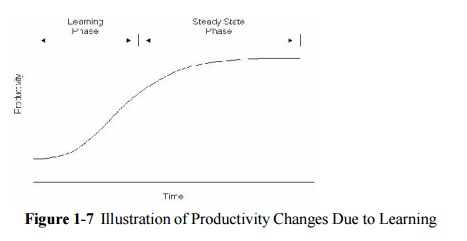
Construction
Planning:
Estimating
Activity Durations
In most scheduling procedures, each work activity
has associated time duration. These durations are used extensively in preparing
a schedule. For example, suppose that the durations shown in Table 9-3 were
estimated for the project diagrammed in Figure 1-0. The entire set of
activities would then require at least 3 days, since the activities follow one
another directly and require a total of 1.0 + 0.5 + 0.5 + 1.0 = 3 days. If
another activity proceeded in parallel with this sequence, the 3 day minimum
duration of these four activities is unaffected. More than 3 days would be
required for the sequence if there was a delay or a lag between the completion
of one activity and the start of another.
All formal scheduling procedures rely upon
estimates of the durations of the various project activities as well as the
definitions of the predecessor relationships among tasks. The variability of an
activity's duration may also be considered. Formally, the probability
distribution of an activity's duration as well as the expected or most likely
duration may be used in scheduling. A probability distribution indicates the
chance that particular activity duration will occur. In advance of actually
doing a particular task, we cannot be certain exactly how long the task will
require.
A straightforward approach to the estimation of
activity durations is to keep historical records of particular activities and
rely on the average durations from this experience in making new duration
estimates. Since the scopes of activities are unlikely to be identical between
different projects, unit productivity rates are typically employed for this
purpose. For example, the duration of an activity Dij
such as
concrete formwork assembly might be estimated as:
Dv = Ag /
FgNg
Where Aij is the required formwork area
to assemble (in square yards), Pij is the average productivity of a
standard crew in this task (measured in square yards per hour), and Nij
is the number of crews assigned to the task. In some organizations, unit
production time, Tij, is defined as the time
required to complete a unit of work by a standard crew
(measured in hours per square yards) is used as a productivity measure such
that Tij is a reciprocal of Pij.
A formula such as Eq. (1.1) can be used for nearly
all construction activities. Typically, the required quantity of work, Aij
is determined from detailed examination of the final facility design. This
quantity-take-off to obtain the required amounts of materials,
volumes, and areas is a very common process in bid preparation by contractors.
In some countries, specialized quantity surveyors provide the information on
required quantities for all potential contractors and the owner. The
number of crews working, Nij, is decided by the planner. In
many cases, the number or amount of resources applied to
particular
activities may be modified in light of the resulting project plan and schedule.
Finally, some estimate of the expected work productivity, Pij must
be provided to apply Equation (1.1). As with cost factors,
commercial services can provide average productivity figures for many standard
activities of this sort. Historical records in a firm can also provide data for
estimation of productivities.
The calculation of a duration as in Equation (9.1)
is only an approximation to the actual activity duration for a number of
reasons. First, it is usually the case that peculiarities of the project make
the accomplishment of a particular activity more or less difficult. For
example, access to the forms in a particular location may be difficult; as a
result, the productivity of assembling forms may be lower than the average
value for a particular project. Often, adjustments based on engineering
judgment are made to the calculated durations from Equation (9.1) for this
reason.
In addition, productivity rates may vary in both
systematic and random fashions from the average. An example of systematic
variation is the effect of learning on productivity. As a crew becomes familiar
with an activity and the work habits of the crew, their productivity will
typically improve. Figure 9-7 illustrates the type of productivity increase
that might occur with experience; this curve is called a learning curve. The
result is that productivity Pij is a function of the duration of an
activity or project. A
common
construction example is that the assembly of floors in a building might go
faster at higher levels due to improved productivity even though the
transportation time up to the active construction area is longer. Again,
historical records or subjective adjustments might be made to represent
learning curve variations in average productivity.
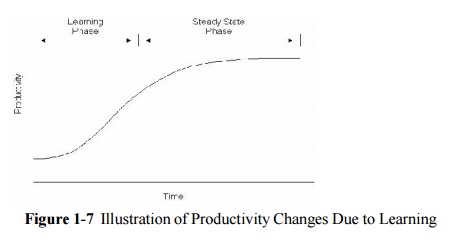
Random factors will also influence productivity
rates and make estimation of activity durations uncertain. For example, a
scheduler will typically not know at the time of making the initial schedule
how skillful the crew and manager will be that are assigned to a particular
project. The productivity of a skilled designer may be many times that of an
unskilled engineer. In the absence of specific knowledge, the estimator can
only use average values of productivity.
Weather effects are often very important and thus
deserve particular attention in estimating durations. Weather has both
systematic and random influences on activity durations. Whether or not a
rainstorm will come on a particular day is certainly a random effect that will
influence the productivity of many activities. However, the likelihood of a
rainstorm is likely to vary systematically from one month or one site to the next.
Adjustment factors for inclement weather as well as meteorological records can
be used to incorporate the effects of weather on durations. As a simple
example, an activity might require ten days in perfect weather, but the
activity could not proceed in the rain. Furthermore, suppose that rain is
expected ten percent of the days in a particular month. In this case, the
expected activity duration is eleven days including one expected rain day.
Finally, the use of average productivity factors themselves cause
problems in the calculation presented in Equation (1.1). The expected value of
the multiplicative reciprocal of a variable is not exactly equal to the
reciprocal of the variable's expected value. For example, if productivity on an
activity is either six in good weather (ie., P=6) or two in bad weather (ie.,
P=2) and good or bad weather is equally likely, then the expected productivity
is P = (6)(0.5) + (2) (0.5) = 4, and the reciprocal of expected productivity is
1/4. However, the expected reciprocal of productivity is E[1/P] = (0.5)/6 +
(0.5)/2 = 1/3. The reciprocal of expected productivity is 25% less than the
expected value of the reciprocal in this case! By representing only two
possible productivity values, this example represents an extreme case, but it
is always true that the use of average productivity factors in Equation (1.1)
will result in optimistic estimates of activity durations. The use of actual
averages for the reciprocals of productivity or small adjustment factors may be
used to correct for this non-linearity problem.
The simple duration calculation shown in Equation
(1.1) also assumes an inverse linear relationship between the number of crews
assigned to an activity and the total duration of work. While this is a
reasonable assumption in situations for which crews can work independently and
require no special coordination, it need not always be true. For example,
design tasks may be divided among numerous architects and engineers, but delays
to insure proper coordination and communication increase as the number of
workers increase. As another example, insuring a smooth flow of material to all
crews on a site may be increasingly difficult as the number of crews increase.
In these latter cases, the relationship between activity duration and the
number of crews is unlikely to be inversely proportional as shown in Equation
(1.1). As a result, adjustments to the estimated productivity from Equation
(1.1) must be made. Alternatively, more complicated functional relationships
might be estimated between duration and resources used in the same way that
nonlinear preliminary or conceptual cost estimate models are prepared.
One
mechanism to formalize the estimation of activity durations is to employ a
hierarchical estimation framework. This approach decomposes the estimation
problem into component parts in which the higher levels in the hierarchy
represent attributes which depend upon the details of lower level adjustments
and calculations. For example, Figure 1-8 represents various levels in the estimation
of the duration of masonry construction. At the lowest level, the maximum
productivity for the activity is estimated based upon general work conditions.
Table 1-4 illustrates some possible maximum productivity values that might be
employed in this estimation. At the next higher level, adjustments to these
maximum productivities are made to account for special site conditions and crew
compositions; table 1-5 illustrates some possible adjustment rules. At the
highest level, adjustments for overall effects such as weather are introduced.
Also shown in Figure 1-8 are nodes to estimate down or unproductive time
associated with the masonry construction activity. The formalization of the
estimation process illustrated in Figure 1-8 permits the development of
computer aids for the estimation process or can serve as a conceptual framework
for a human estimator.
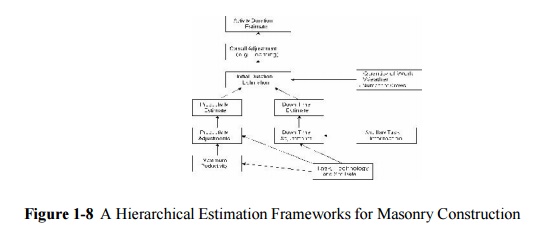
In addition to the problem of estimating the
expected duration of an activity, some scheduling procedures explicitly
consider the uncertainty in activity duration estimates by using the
probabilistic distribution of activity durations. That is, the duration of a
particular activity is assu med to be a random variable that is distributed in
a particular fashion. For example, an activity duration might be assumed to be
distributed as a normal or a beta distributed random variable as illustrated in
Figure 9-9. This figure shows the probability or chance of experiencing a
particular activity duration based on a probabilistic distribution. The beta
distribution is often used to characterize activity durations, since it can
have an absolute minimum and an absolute maximum of possible duration times.
The normal distribution is a good approximation to the beta distribution in the
center of the distribution and is easy to work with, so it is often used as an
approximation.
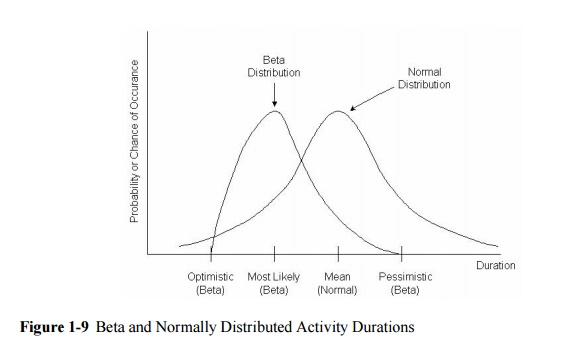
If a standard random variable is used to
characterize the distribution of activity durations, then only a few parameters
are required to calculate the probability of any particular duration. Still,
the estimation problem is increased considerably since more than one parameter
is required to characterize most of the probabilistic distribution used to
represent activity durations. For the beta distribution, three or four
parameters are required depending on its generality, whereas the normal
distribution requires two parameters.
As an example, the normal
distribution is characterized by two parameters, ![]() and
and ![]() representing the average duration and the
standard deviation of the duration, respectively. Alternatively, the variance
of the distribution
representing the average duration and the
standard deviation of the duration, respectively. Alternatively, the variance
of the distribution ![]() could be used to describe or characterize the
could be used to describe or characterize the
variability
of duration times; the variance is the value of the standard deviation
multiplied by itself. From historical data, these two parameters can be estimated
as:
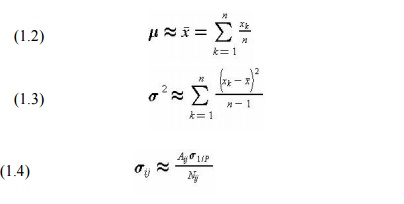
where we assume that n different observations xk
of the random variable x are available. This estimation process might be
applied to activity durations directly (so that xk would be a record
of an activity duration Dij on a past project) or to the estimation
of the distribution of productivities (so that xk would be a record
of the productivity in an activity Pi) on a past project) which, in
turn, is used to
estimate
durations using Equation (1.4). If more accuracy is desired, the estimation equations
for mean and standard deviation, Equations (1.2) and (1.3) would be used to
estimate the mean and standard deviation of the reciprocal of productivity to
avoid non-linear effects. Using estimates of productivities, the standard
deviation of activity duration would be calculated as:
where Ro (p) is the estimated standard deviation of the
reciprocal of productivity that is calculated from Equation (1.3) by
substituting 1/P for x.
Related Topics